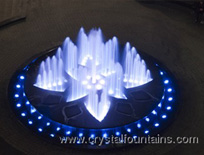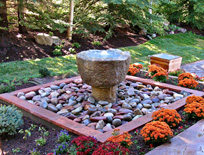fountain
Toronto-based Crystal Fountains has designed a dramatic, multifunctional waterfeature for White Square Office Center, a major new commercial development in Moscow. The company describes
It’s frequently tough to figure out how a person ever finds his or her way into a specific line of work. In my case, for example, I more or less fell into the faux-rock trade, never imagining that what seemed like a blind stumble would ultimately unlock my imagination in a whole range of unexpected ways. It all started when I was working in the oil industry in Alaska in the 1980s. When petroleum prices dropped, I was out of work and moved back to my home town of Tucson, Ariz., where I was hired as a laborer by the Larson Company, which was among the trailblazing firms starting to work in faux rock. I began by mixing concrete and did my fair share of grunt work. As luck would have it, I began showing some artistic promise and in a relatively short time found myself working on major projects and learning the process literally from the ground up. After a couple of hard years, I became a superintendent, a promotion that led to my involvement in major overseas projects, including aquariums in Tokyo and Osaka, Japan, as well as an extended stay in Italy. These were wonderful, formative experiences, but eventually I struck out on my own and
Oddly enough, this story takes place in a down economy and shows how, despite perceived financial limitations, something surprising and wonderful can happen when people put their minds to it. For years now, my work at Aquascape (St. Charles, Ill.) has largely focused on developing, designing and installing systems that in one or more ways are environmentally sound and beneficial. In early 2009, I began working on a plan for a prototype community designed around optimal use of its resources, especially water. I imagined a town filled with rainwater-capturing systems, permeable surfaces and efficient irrigation. It included nothing but indigenous plants, was organized with minimal turf areas and set aside space for composting and cooperative organic farming. As for the homes, all of them boasted various resource- and energy-efficient features. The overall concept was so
Through the years, my experience in designing and building naturalistic and architectural watershapes has led me into several situations in which my clients have wanted to use a special heirloom or artifact of some kind as
It was no easy task: We were called on to take the majestic landscape defined by the confluence of the Mississippi and Missouri rivers; use it as a template for an urban oasis filled with sculptures, plants and water; and develop a park that would mesh seamlessly with its surrounding urban spaces. Furthermore, they wanted this park to appeal to every conceivable user – people of all ages, needs and backgrounds – while also serving as a catalyst for growth and a profound revival of the city’s core. And not only was the space to carry that symbolic load, but it also had to function efficiently with long-term reliability. We at Hydro Dramatics (St. Louis, Mo.) know from experience that projects of this scope and scale require much planning and coordination to go along with large measures of innovation. We also know that these types of challenges make success that much sweeter. So we jumped into the task with all our energy, supporting the design team charged with developing Citygarden, a 2.9-acre parcel to be filled with
Root Design has always focused on developing environments that delight, inspire and occasionally surprise clients, but the project seen in this, the first of two articles, may well be the company’s most elaborate to date. Here, Ben Dozier and Michael Percy describe what went into designing and building across the entire site, including the multiple watershapes that helped transform this estate into an oasis filled with plants, light, sounds and water. Although it doesn’t always work out this way, the best-case scenario for us at Root Design (Austin, Texas) is to accept full responsibility for all exterior spaces of a given property, from the footprint of the house out to the property lines. In these situations, our team is able to establish designs with wall-to-wall continuity in response to the environment, the architecture and our client’s wishes. We commit ourselves in these circumstances to taking homeowners and their guests on a journey, starting the moment they enter the property and moving all the way through to the yard’s farthest reaches and all the spaces in between. Along the way, they’ll enter a variety of small or large vignettes, conceal-and-reveal discoveries, dramatic focal points and multiple rewarding destinations – each conceptually linked as a coherent “whole.” In this case, we were called upon to
I must say that I look forward to receiving my own copy of WaterShapes in the mail each month. It’s not because I can’t wait to see my own columns in print; rather, it’s because so I’m amazed and inspired by the work watershapers put on display here that I always devour each and every page. That’s not, by the way, anything I’d say about the rest of the 30-odd trade magazines I receive via mail or e-mail. WaterShapes always seems to deal with the best of the best, and reading about how these incredible projects come together is
Sometimes, the main idea that will drive a design jumps to mind as soon as you see the site. That was the case with the project covered here: When I pulled up to the gate of the property - high in the affluent hills of Bel Air, Calif. - what I found wasn't a big, showy home of the sort that have increasingly come to characterize the neighborhood; instead, what I saw was a place defined by subtlety and elegance. It all started with the gate's beautiful brick pilaster, beyond which I could just glimpse a large, lovely home with the distinctive architecture of an English manor house. Even though I hadn't met the clients yet or seen the entire job site, I was already convinced that the project would be
Sometimes, the main idea that will drive a design jumps to mind as soon as you see the site. That was the case with the project covered here: When I pulled up to the gate of the property - high in the affluent hills of Bel Air, Calif. - what I found wasn't a big, showy home of the sort that have increasingly come to characterize the neighborhood; instead, what I saw was a place defined by subtlety and elegance. It all started with the gate's beautiful brick pilaster, beyond which I could just glimpse a large, lovely home with the distinctive architecture of an English manor house. Even though I hadn't met the clients yet or seen the entire job site, I was already convinced that the project would be
As a sculptor, I always seek ways to use my work to create positive (and sometimes intellectually challenging) experiences for those who have the opportunity to see what I've done. In my case, most of the time I'm not trying to make direct, narrative or literal statements. Instead, I seek to conjure feelings of fascination that lead to appreciation and enjoyment: You don't necessarily have to understand the forms I create to walk away from them with good feelings. When I have the opportunity to work in public settings (as was the case in the project featured on these pages), I'm stimulated by the idea that large numbers of people will be exposed to my sculpture and that, in many cases, those people will be exposed to what I've done over and over again because they'll be passing by at least twice each day as they go to and from their jobs in adjacent buildings. In this case, I was working next to an office tower in Century City - a famous business and entertainment district near downtown Los Angeles - which meant that thousands would repeatedly be walking right past my work and would come to accept it as part of their daily lives. In that light, I see art set amid architecture as a permanent commitment, as a cultural reference that has the potential to resound for generations. This recognition fills me with a heightened sense of





















